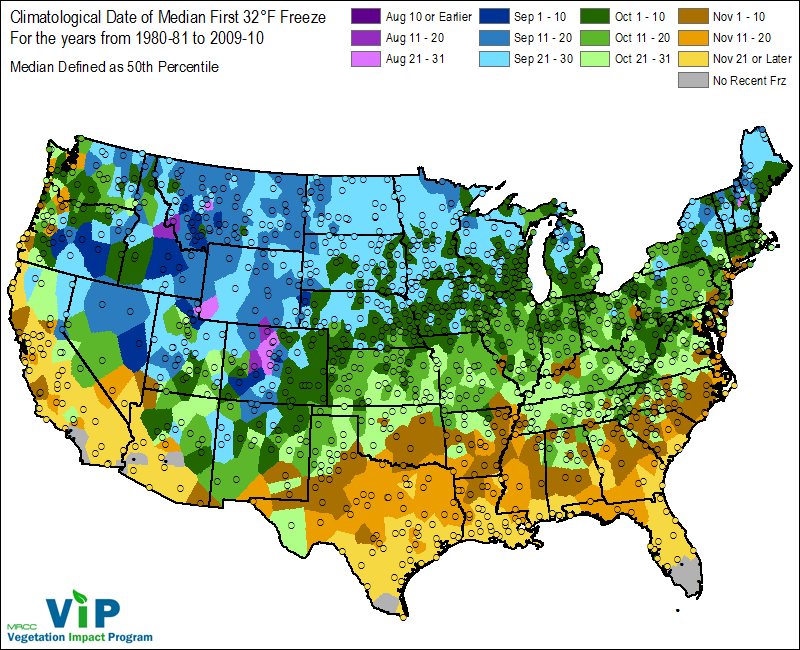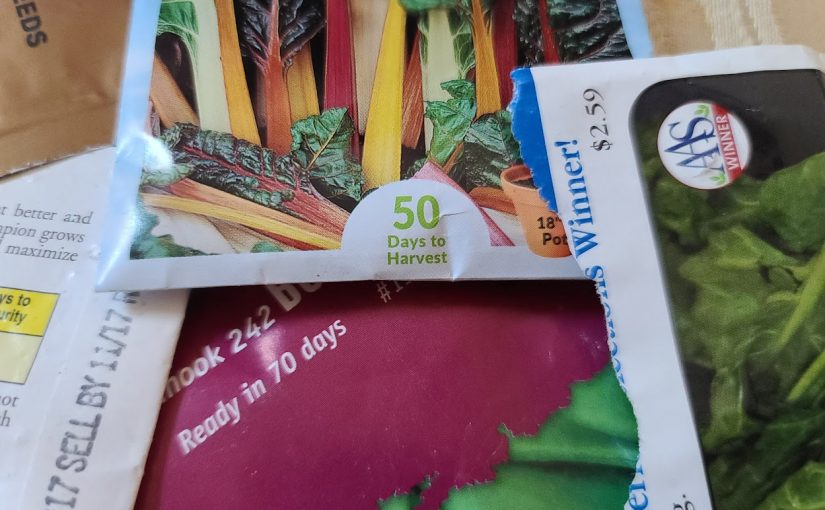While most of the US is still seeing sweltering hot temps, the cool temps of fall and winter aren’t really all that far away for those of us unlucky (or lucky) enough to not live in a tropical climate. The tomatoes, peppers, cucumbers, and other warm-season crops planted back at the beginning of summer are still puttering along, even if they might be getting a little long in the tooth and starting to look a little worse for wear ( especially if disease has ravaged them). For those who aren’t quite done with gardening for the year or who want to reap the bounty of fall crops and get the most out of their production space, fall gardening can be a great tool to extend the garden season. But knowing when to plant what is tricky, especially when we are talking about different weather patterns and frost dates all around the country. So a bit of weather data, info from the seed packet or label, a touch of math, and a calendar can be great tools to figure out when you can plant no matter where you are. Of course if you do live in one of those warmer tropical areas your planting calendar is kind of turned on its head from what us more northern gardeners face. You may prefer to time your planting to avoid high heat.
The first thing to think about is what you can plant. Cool-season crops such as the Cole crops (cabbage, kale, broccoli, etc.), leafy greens (lettuce, spinach, Bok choi, etc.), root crops (radishes, beets, turnips, scallions), and some cool weather loving herbs like cilantro and parsley are all par for the course for a garden going into cooler fall and winter temps. Depending on when you have extra space in your garden to plant and how long your growing season is you can often sneak in a late planting of fast-growing warm season crops to mature before the last frost. Beans, cucumbers, and summer squash all have varieties that are fast maturing and can be started mid-summer for an early fall harvest. Unfortunately, as of this writing the window for those warm-season crops has passed for me, but others in warmer zones may still have time.
One question I get asked often is whether you should start indoors or out. I always tell folks that for things normally direct-seeded, like beans or lettuce, sow as normal. For things that are normally started indoors, the choice is yours. Cole crops are started indoors in spring because they need warmer temps to germinate. Since it is hot outside, you won’t need to grow them indoors for the heat (though it may be too hot outdoors if temps are over 85). You can start them in containers in a protected area outdoors instead of trying indoors. Theoretically you could direct seed them into the garden, but management is difficult to keep them watered, weed-free, and alive out there in the cruel garden world.
To know what you can plant and when, the first bit of info you’ll need is from the seed packet or label (or do some research if you know the cultivar/variety). You’ll want to know the “days to maturity”, which is an estimate of how long it will take to go from seed (or transplant) to edible crop. For those warm season crops, you might want to shop around because those days to maturity can be wildly variable – you can find beans that mature in 60-65 days and some that take 100+. You’ll want to choose faster maturing varieties.
Assuming that you’ll want a harvest window longer than a day and given that plant growth slows down as temperature cools (respiration is temperature dependent so plant processes slow down as temperatures drop), you’ll want to add a few weeks to the maturity days to take that into account. This should be sufficient for cool season crops that will survive well past the first frost and freeze dates. The aim for cool season crops is to get them close to a mature size before cold weather sets in since their growth will slow down at that point. For warm season crops you’ll want to add a little more time to provide a cushion against frost which will kill the plants. For info on killing temperatures of certain crops, check out my previous article here.

For example, if I wanted to plant Asian Delight Bok choi (I fell in love with it when I trialed it for the All-America Selections program) I’d see on the packet that it has an average maturity time of 37 days (which is pretty damn fast). My math would be:
37 days (to maturity) + 14 days (harvest period) + 14 days (fall factor) = 65 days
Next, you’ll need to know a bit of weather data – more specifically the expected date of your first frost/freeze. You can find this on the website of your local National Weather Service office, or get an idea from the map below. (This data is usually updated every decade or so – you’ll want to check it every few years for updates as the dates have been changing due to climate change.) The date ranges given are usually a median, meaning that half of the frost days fall before and half fall after the given dates. Keep that in mind – sometimes frost will come earlier or be much later.

I live in Omaha, Nebraska so our median frost date (according to the map) is Oct 10. Now I know that I need to plant my Asian Delight Bok choi 65 days before Oct 10. I can grab a calendar and count backward from October 10 (or I can cheat and use an online date calculator like this one) and see that the suggested planting date is August 6. Since I missed it by a week I can decide if I want to gamble a little and still plant since I know that it could very well frost later than Oct 10 and that the Bok choi will survive much later into the season anyway. But it gives me an idea of what to expect.
Had I wanted to plant something like beans for a late crop, my calculation would have definitely shown me that it was too late, letting me know that I shouldn’t waste my time. For example, Blue Lake beans take around 55-60 days to mature (almost twice as long as my Bok choi), plus I need to add that extra 14 days for the frost factor meaning that I would have had to plant 97 days before first frost, which would have been in early July for me.
You can extend the time you have for growing fall crops by using season extension techniques like row covers, low tunnels, cloches, etc. For row covers, the materials you buy such as the spun fabric row cover will offer a certain number of degrees of protection. For example, a medium weight row cover might offer 8 degrees of protection, meaning it will be 8 degrees warmer under the cover than the air temp. Keep those in mind when planning your fall garden. Perhaps we’ll have to talk about those in another article soon.
Sources:
Fall Gardening (Nebraska Extension)
Fall Vegetable Gardening (Virginia Cooperative Extension)

4 thoughts on “Counting the Days to Maturity: Calculating planting dates for fall vegetables”